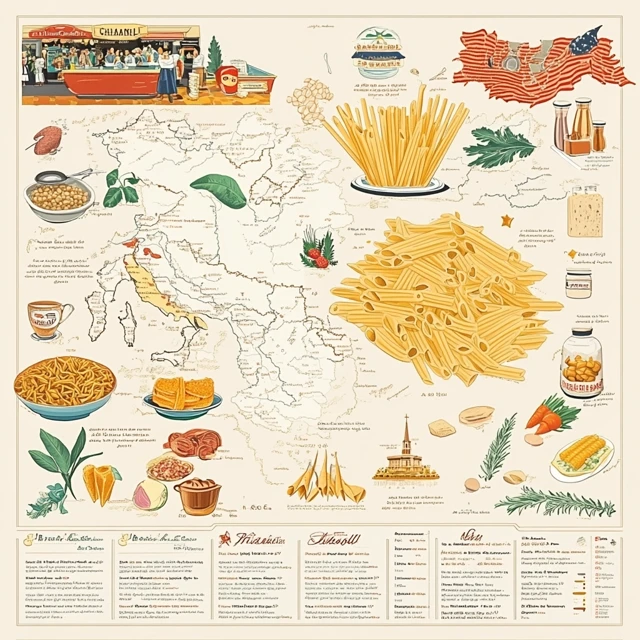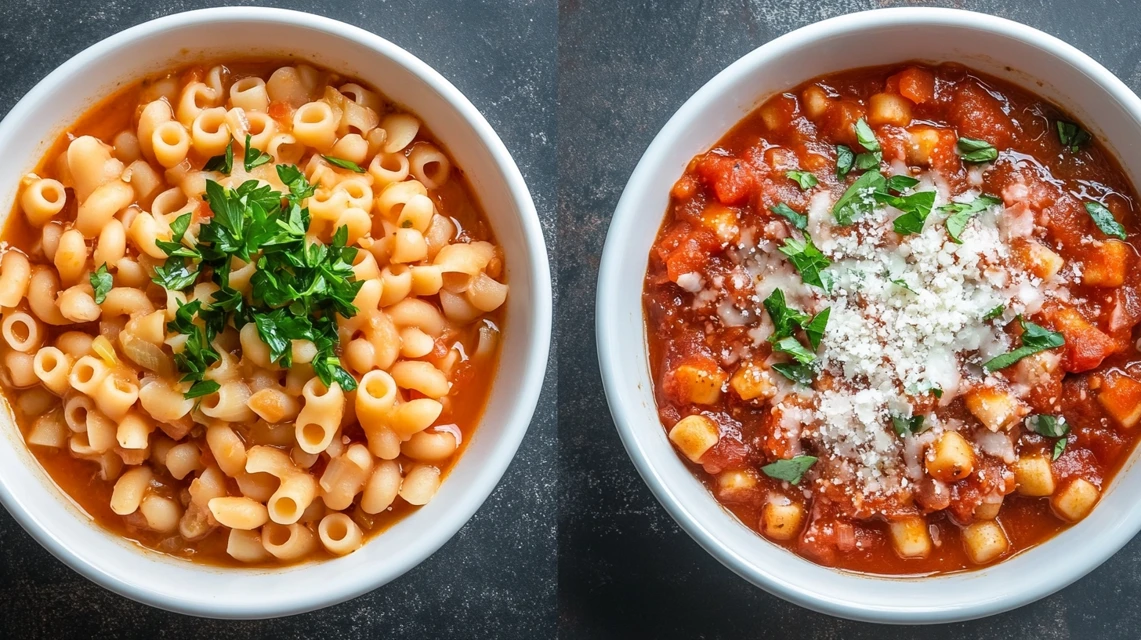Pasta Fagioli, often affectionately referred to as “Pasta Fazool” in the United States, is a hearty Italian dish that has found a home in kitchens across the world. But many people wonder—are they the same dish? The short answer is yes, but the difference lies in pronunciation, cultural influence, and regional variations. Let’s explore the meaning behind these names and how the dish has evolved over time.
Understanding the Terms Pasta Fagioli and Pasta Fazool
Both Pasta Fagioli and Pasta Fazool refer to the same beloved dish made from pasta and beans. The names are used interchangeably, but they originate from different linguistic and cultural influences.
The Meaning of Pasta Fagioli
In standard Italian, Pasta Fagioli (pronounced “pah-stah fah-joh-lee”) directly translates to “pasta and beans.” The name perfectly describes the dish’s two primary ingredients—small pasta (such as ditalini) and creamy beans (such as cannellini or borlotti).
Above all, the dish has earned widespread recognition for its elegant simplicity and exceptional nutritional value, thus securing its position as a cornerstone of Italian cuisine. Furthermore, while Pasta Fagioli traditionally emerged as a “peasant dish” due to its remarkably inexpensive and satisfying ingredients, nowadays it draws enthusiastic admirers worldwide who cherish its comforting flavors and rich cultural heritage.
check out this https://eassyrecipes.com/category/dinner/
Why Is It Called Pasta Fazool?
Specifically, the term Pasta Fazool comes from the Neapolitan dialect, where people say the Italian word fagioli (beans) as fazool. Then, when Southern Italian immigrants came to the United States in the late 19th and early 20th centuries, they brought this unique way of saying it with them. Over time, the term grew strong roots and spread throughout Italian-American communities, where people still use it today.
In fact, in cities like New York, where many Italian immigrants made their new homes, Pasta Fazool became everyone’s favorite way to refer to this comfort food. The name caught on even more as it started showing up in American songs, movies, and popular culture.
check out this https://eassyrecipes.com/category/dinner/
Regional Differences in Pronunciation

The pronunciation of Pasta Fagioli shifts as you travel through different regions of Italy. Let’s explore how people say it across the country:
First, in Northern Italy, locals use the standard pronunciation fah-joh-lee, which follows traditional Italian speech patterns.
Meanwhile, if you journey to Southern Italy, particularly Naples and its surrounding areas, you’ll hear it commonly pronounced as fazool – this unique regional pronunciation later shaped the American version of the name.
Moving on to Sicily, the pronunciation takes on yet another form, where speakers place special emphasis on the “gi” sound, creating its own distinct regional flavor.
However, no matter how people say the name across these regions, the heart of the dish stays the same—a warm, filling meal of pasta and beans that brings comfort to any table.
The History and Cultural Influence of the Dish
Pasta Fagioli has a long history that dates back centuries in Italy, where it was enjoyed by both the wealthy and the working class. Over time, as Italian immigrants introduced it to the U.S., the dish took on new variations and flavors.
How Pasta Fagioli Originated in Italy
Originally a peasant dish, Pasta Fagioli was created using simple, readily available ingredients such as dried beans, pasta, garlic, and olive oil. Over time, different regions in Italy developed their own unique variations by incorporating local ingredients.
To illustrate these regional differences, consider how in northern Italy, cooks often create a luxuriously creamy consistency by carefully mashing some of the beans into the broth. Meanwhile, as you travel toward southern Italy, the dish transforms significantly, as chefs tend to embrace a lighter, more broth-based approach while delicately incorporating subtle touches of herbs and spices.
How the Dish Evolved in America
When Italian immigrants brought Pasta Fagioli to the United States, they adapted the recipe based on the ingredients available in their new homes. American versions often include:
- The addition of tomatoes, which are not always used in traditional Italian recipes.
- A thicker, stew-like consistency that makes it more filling.
- The use of canned beans and pre-packaged pasta for convenience.
The dish also became a symbol of Italian-American culture, often served at family gatherings and celebrations. It became especially popular during the Great Depression when families relied on affordable, filling meals.
check out this https://eassyrecipes.com/category/dinner/
Differences in Ingredients Between Italian and American Versions

Though the core ingredients remain the same, some key differences exist between the traditional Italian and American versions of Pasta Fagioli:
| Ingredient | Traditional Italian Version | American Version |
|---|---|---|
| Pasta | Ditalini, small shells | Elbow macaroni |
| Beans | Cannellini or borlotti | Canned white beans |
| Tomatoes | Optional or minimal | More commonly added |
| Broth | Light and herb-infused | Thick and hearty |
| Meat (optional) | Pancetta or none | Sausage or ground beef |
Despite these variations, both versions retain the comforting essence of Pasta Fagioli.
Ingredients and Cooking Variations of Pasta Fagioli
First and foremost, Pasta Fagioli emerges as a simple yet remarkably versatile dish that creative cooks prepare in countless different ways, adapting it according to both regional preferences and locally available ingredients. As a result, whether you gravitate toward the traditional Italian interpretation or embrace the American adaptation known as “Pasta Fazool,” understanding these diverse variations will ultimately guide you toward crafting the perfect recipe that aligns with your unique taste preferences.
Traditional Italian Pasta Fagioli Recipe
First and foremost, the authentic Italian version of Pasta Fagioli stands out for its remarkable simplicity, as skilled cooks combine fresh, wholesome ingredients to create a dish bursting with flavor and texture. Consequently, when exploring a traditional recipe, you’ll typically discover the following essential components:
Ingredients:
- Pasta: Small shapes such as ditalini or small shells.
- Beans: Cannellini or borlotti beans, often cooked from scratch.
- Tomatoes: Fresh tomatoes or a small amount of tomato paste for flavor.
- Broth: Light vegetable or meat-based broth.
- Aromatics: Onion, garlic, celery, and carrots.
- Herbs: Fresh rosemary, thyme, or bay leaves.
- Olive Oil: Used for sautéing and drizzling on top before serving.
- Parmesan Cheese: A sprinkle of grated Parmesan or Pecorino Romano for garnish.
Cooking Method:
- Heat olive oil in a large pot, sauté onion, garlic, carrots, and celery until softened.
- Add beans, broth, and herbs, allowing it to simmer gently.
- Cook the pasta separately and add it just before serving.
- Finish with a drizzle of olive oil and grated cheese for a rich flavor.
This traditional version is light and broth-based, allowing the natural flavors of the ingredients to shine through.
Common American Adaptations
When Pasta Fagioli was introduced to the United States by Italian immigrants, it underwent changes to suit local tastes and available ingredients. The American version, often called Pasta Fazool, tends to be heartier and more tomato-heavy.
Key differences in the American version:
- Pasta Choice: Elbow macaroni or even broken spaghetti are common substitutes for traditional ditalini.
- Beans: Canned beans are often used for convenience.
- Tomatoes: Canned diced tomatoes or tomato sauce is added for a richer, thicker broth.
- Broth: Often thicker and more stew-like compared to the traditional version.
- Meat Additions: Ground beef, sausage, or pancetta are sometimes included for added flavor.
- Seasonings: Garlic powder, red pepper flakes, and Italian seasoning blends enhance the flavor profile.
Cooking Method:
- Brown meat in olive oil if using, then add onions, garlic, and vegetables.
- Stir in tomatoes, beans, and broth, allowing the flavors to meld.
- Add cooked pasta and serve with generous amounts of grated cheese.
This version is more filling and is often enjoyed as a stand-alone meal.
Thick vs. Brothy Versions of the Dish
Pasta Fagioli can be enjoyed in a variety of textures, from a thick stew to a light soup, depending on how it’s prepared.
1. Thick Version:
- Often preferred in American adaptations.
- Achieved by mashing some of the beans to create a creamy consistency.
- Great as a filling, one-pot meal.
2. Brothy Version:
- More common in traditional Italian preparations.
- Achieved by using a lighter broth and adding pasta just before serving to prevent thickening.
- Served with crusty bread for dipping.
Whether you prefer it thick or brothy, both versions deliver a satisfying and nutritious meal.
Popular Ingredient Substitutions
If you want to customize your Pasta Fagioli, consider these common ingredient substitutions:
- Gluten-Free Option: Swap traditional pasta for gluten-free varieties such as chickpea or rice pasta.
- Vegan Option: Use vegetable broth and skip the cheese, replacing it with nutritional yeast for a cheesy flavor.
- Low-Carb Option: Substitute pasta with zucchini noodles or cauliflower rice.
- Spicier Version: Add chili flakes or a dash of hot sauce for extra heat.
These adjustments make it easy to tailor the dish to dietary preferences without sacrificing flavor.
Tips for Perfect Pasta Fagioli Every Time
To ensure your Pasta Fagioli turns out delicious with every attempt, follow these helpful tips:
- Cook Pasta Separately: Adding pasta directly to the soup can cause it to become mushy. Always cook it separately and add it before serving.
- Simmer Slowly: Allow the ingredients to simmer gently to develop deeper flavors.
- Season Gradually: Start with less salt and adjust based on taste. Remember that Parmesan cheese adds a salty touch.
- Prepare in Advance: Pasta Fagioli often tastes even better the next day as the flavors continue to meld.
- Use Fresh Herbs: If possible, use fresh rosemary and thyme for a more aromatic result.
FAQs About Pasta Fagioli vs. Pasta Fazool
Many people wonder whether there’s a difference between Pasta Fagioli and Pasta Fazool. While they refer to the same delicious dish, the variation in name and pronunciation can cause some confusion. Let’s dive into the most commonly asked questions to clarify the differences and understand the cultural significance of this classic meal.
What Is the Difference Between Pasta Fazool and Pasta Fagioli?
To begin with, there is no actual difference in the dish itself—Pasta Fagioli and Pasta Fazool represent the same beloved meal. Rather, the key distinction emerges in pronunciation and cultural adaptation.
On one hand, Pasta Fagioli (pronounced “pah-stah fah-joh-lee”) stands as the standard Italian term, which directly translates to “pasta and beans.” As such, people commonly use this pronunciation throughout Italy and among Italian speakers worldwide.
On the other hand, Pasta Fazool evolved as the Americanized version of the dish’s name. Specifically, this variation originates from the Southern Italian and Neapolitan dialect, where speakers pronounce the word for beans, fagioli, as fazool.
Subsequently, when Italian immigrants brought their regional dialects to the U.S., the term fazool naturally took root and, over time, flourished as the widely recognized name in Italian-American com[munities].munities. Despite the name variation, both refer to the same comforting pasta and bean dish.
Why Do Italian Americans Say Pasta Fazool?
Italian Americans say Pasta Fazool because of their Southern Italian heritage. When many Italian immigrants came to the United States in the late 19th and early 20th centuries, they primarily came from Southern regions like Naples and Sicily, where dialects differed significantly from standard Italian.
In the Neapolitan dialect, fagioli (beans) is pronounced fasule or fazool. As Italian immigrants settled in places like New York and Chicago, they continued using their familiar pronunciation, which eventually became part of Italian-American culture and language.
This adaptation extended beyond the kitchen and into popular culture, with songs, movies, and conversations referencing Pasta Fazool. One famous example is Dean Martin’s song That’s Amore, where he sings, “When the stars make you drool just like pasta fazool, that’s amore.”
Even though the pronunciation has evolved, the dish remains a cherished staple in Italian-American homes.
What Does Fazool Mean in Italian?
Technically, fazool itself is not an Italian word. It is a phonetic adaptation of the Neapolitan dialect term for fagioli, which means “beans” in Italian.
In standard Italian, the word fagioli is used to refer to various types of beans, such as:
- Cannellini Beans: White kidney beans, commonly used in Pasta Fagioli.
- Borlotti Beans: Creamy beans with a nutty flavor, often used in Italian stews.
- Chickpeas (Ceci): Used in a variety of Mediterranean dishes.
Although the pronunciation may differ, fazool and fagioli both refer to the same nutritious and hearty ingredient that gives Pasta Fagioli its signature flavor and texture.
How Do Italians Say Fagioli?
In standard Italian, the word fagioli is pronounced as “fah-joh-lee,” with a soft “j” sound and emphasis on the second syllable. This pronunciation is commonly used throughout central and northern Italy.
However, different Italian regions have their own unique pronunciations:
- Northern Italy: A clearer, standard pronunciation—fah-joh-lee.
- Southern Italy (Neapolitan dialect): Pronounced as fazool, which became popular in the U.S.
- Central Italy (Roman dialect): Often pronounced as fah-jo-lee, with softer tones.
Italians take great pride in their regional dialects and culinary traditions, and these small variations in pronunciation add charm to the cultural diversity within the country.
Conclusion
First of all, the difference between Pasta Fagioli and Pasta Fazool comes from language and culture, not from the dish itself. So whether you like the traditional Italian way of saying it or the American way, this warming comfort food keeps bringing joy to families through the years.
Also, as this loved dish made its way from its simple beginnings in Italy to become popular in the United States, Pasta Fagioli stands for comfort and tradition. No matter what you call it, this special dish shows how food can bring different cultures together and connect older and younger generations.
So the next time you enjoy a bowl of Pasta Fagioli—whether you say fagioli or fazool—think about how you’re taking part in a food tradition that goes beyond borders and brings people together through their love of good food.

